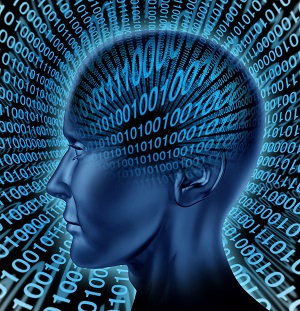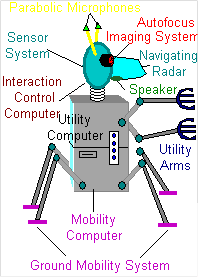01 Dec Robot Neurons: Analog versus Digital
 Digital is basically black and white: 1 is yes and 0 is no or vice-versa. Yet our world is full of other colors. We can efficiently use digital devices to stretch arbitrary numbers of 1’s and 0’s together to represent a virtually infinite degree of possible values. Yet there are places where exactly two values may be the best process model .to perform tasks. As an example, many rules state that if a certain value is true, then do one thing, and if not, then do this other thing (simple branching). In fact, no matter how many dimensions there are to a rule, it can be “flattened out” to a string of simple IF – THEN – ELSE rules. This is not the only way of processing information, but we do it this way today.
Digital is basically black and white: 1 is yes and 0 is no or vice-versa. Yet our world is full of other colors. We can efficiently use digital devices to stretch arbitrary numbers of 1’s and 0’s together to represent a virtually infinite degree of possible values. Yet there are places where exactly two values may be the best process model .to perform tasks. As an example, many rules state that if a certain value is true, then do one thing, and if not, then do this other thing (simple branching). In fact, no matter how many dimensions there are to a rule, it can be “flattened out” to a string of simple IF – THEN – ELSE rules. This is not the only way of processing information, but we do it this way today.
But the brain is not digital. “A net neurological effect is usually not the result of a neuron firing once, but rather a series of firings. A neuron can increase or decrease how much it is firing by changing the frequency of its repeated firing. The higher the frequency, the stronger the signal. So it is more accurate to think of a signal coming from a neuron not as a single all or nothing event, but an ongoing chain of signals at a certain frequency, and this frequency can be increased or decreased along a continuum – hence it is ultimately analog.”
“Second, a neuron receives signals typically from multiple other neurons – some of these will be excitatory and others will be inhibitory, and each of these signals can vary in strength. The net output of the neuron is determined partly by the sum of all the excitatory and inhibitory signals it is receiving – again varying along a continuum, and hence an analog signal. As an aside, I said partly due to the sum of its inputs because neuronal function is also modified by the local environment as well as its own biochemistry.”
“Finally, the strength of connections between neurons also varies along a continuum. A single firing of a neuron does not have the same effect on a neuron to which is synapses, because the firing neuron can have either a weak or a strong connection to the next neuron. Anatomically this is determined by the number of physical synapses that are formed and the tightness of those synapses – literally the distance from the pre-synaptic membrane to the post-synaptic membrane. So the signal strength of even a single neuronal firing (the fundamental unit of neuronal signaling) can vary in an analog fashion” (Novella 2007).
Can artificial intelligence help us design better robots? If so, how do we string digital 1’s and 0’s together correctly, or is the model analog versus digital? If it’s analog, how many values are there: 3, 7, 40? Standards for analog computing are not yet mature enough for us to know the answer today. But let’s talk a little bit about the implications based on what we have learned about human brain cells.
| Understanding Context Cross-Reference |
|---|
| Click on these Links to other posts and glossary/bibliography references |
|
|
|
| Prior Post | Next Post |
| Context Powers Backward Chaining Logic | Language Expressiveness |
| Definitions | References |
| flip-flop | SparkFun Tutorial Novella 2007 |
| digital | How Stuff Works: Robots |
| analog | Wikipedia on Analog Computing |
| modeling | WIRED Magazine (McMILLAN) |
The “Zero, One Infinity” rule in digital design engineering is about efficiency in modeling data input, storage and access. When you design a thing that is intended to handle data, the rule states, it is most efficient to design it to handle nothing or a null set, a single element or a set with exactly one member, or an unlimited number of possible elements: an infinite set. Does analog information engineering need to be as constrained in this manner?

Neurons in a Robot
Human neurons are analog or able to process many levels of voltage at each synapse. Digital logic, limited to two voltages, is usually implemented in silicon components with tiny voltages. For example, a binary register may store -3 millivolts to represent a “false” value and +3 mV to represent a “true” one. Analog logic can use multiple voltages to represent values between the end points on a continuum. Our friend MIPUS (Mobile Interactive Personal Utility System) Robot uses both digital and analog voltages. His use of these voltages is both frugal and judicious.
His optical-imaging system uses analog signals. This system has several large two-dimensional matrices of registers linked to form a neural network. The first matrix is like the chemical emulsion on photographic film. When light strikes any part (or pixel) of the matrix, it reacts to the intensity. Since human eyes can perceive multiple levels of light, MIPUS’ visual matrix was designed with analog pixels so he, too, can perceive different levels of light.
Most of MIPUS’ neurons, however, are digital. They are logic gates and flip-flops that respond to binary signals representing streams of values or true/false logic. The streams of values can symbolize numbers, words, or images. MIPUS is quite proud of his brains.
 When MIPUS sees objects, he analyzes them and acts on instinct to avoid them. The design of this neural network includes both layers with digital nodes, used to represent the layers of the visual cortex, and layers with analog nodes used to perform complex cognitive functions including recognition and warning. The correlating layer is used to provide priming before input signals are received, and to bind two dimensional processes such as visual image scene analysis to multi-dimensional processes such as recognition and warning. The output layer gives MIPUS either the name of the object (if he recognizes it) or a cue to avoid it.
When MIPUS sees objects, he analyzes them and acts on instinct to avoid them. The design of this neural network includes both layers with digital nodes, used to represent the layers of the visual cortex, and layers with analog nodes used to perform complex cognitive functions including recognition and warning. The correlating layer is used to provide priming before input signals are received, and to bind two dimensional processes such as visual image scene analysis to multi-dimensional processes such as recognition and warning. The output layer gives MIPUS either the name of the object (if he recognizes it) or a cue to avoid it.
As I continue to add posts to this blog about understanding context, I will show how these inherently multi-dimensional processes may occur in our brains and how we might more effectively model them in automated systems. I will continue to trot out MIPUS and get his perspectives on how to use these ideas in real life.
| Click below to look in each Understanding Context section |
|---|








